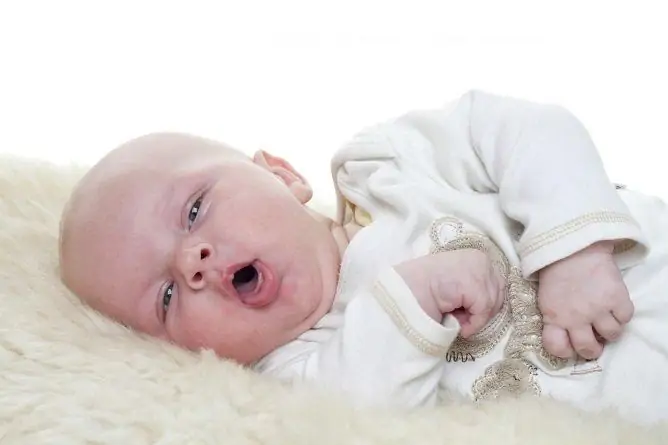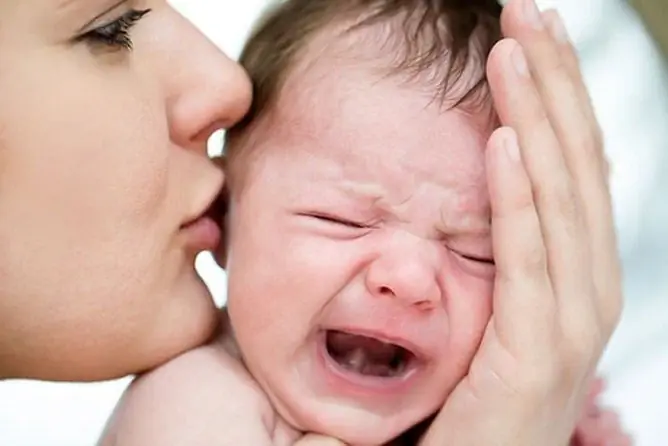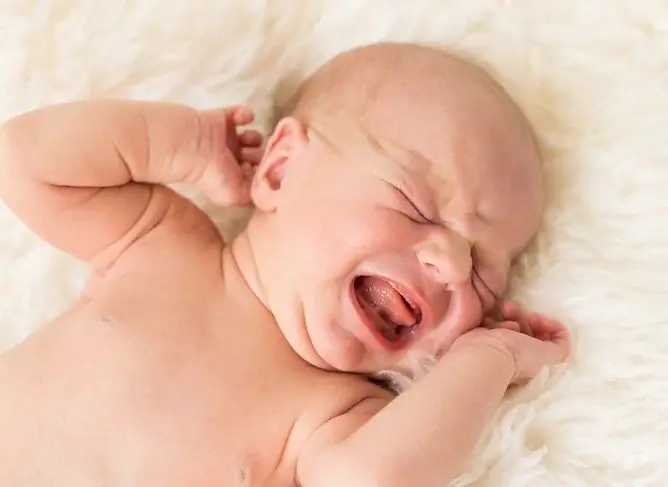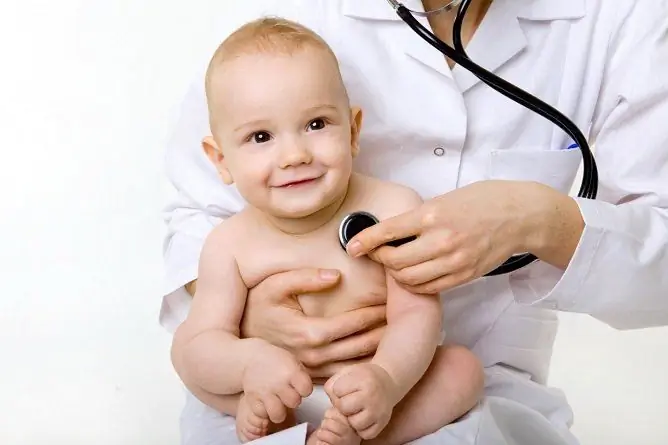- Author Rachel Wainwright [email protected].
- Public 2023-12-15 07:39.
- Last modified 2025-11-02 20:14.
Bronchitis in infants: symptoms, main causes, treatment
The content of the article:
- What are the signs of bronchitis in infants?
- Causes and risk factors
- How to treat bronchitis in infants
- What is forbidden to do with bronchitis in infants
- Video
Symptoms of bronchitis in infants at the onset of the disease may not be pronounced enough, while timely seeking medical help is critical, so it is advisable for parents to know about the manifestations of the disease.
In infants, bronchitis is more severe than in older people, as they have insufficiently developed immune systems, as well as respiratory muscles.
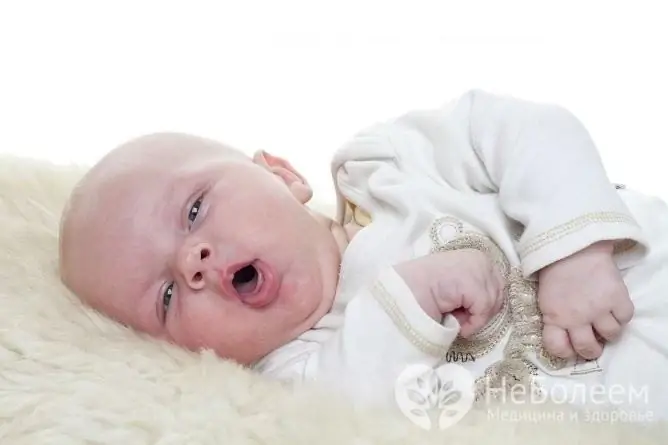
Suspected bronchitis in an infant requires immediate medical attention.
What are the signs of bronchitis in infants?
Bronchitis is an inflammatory disease in which the mucous membrane of the bronchi is involved in the pathological process.
At the onset of the disease, children usually have nasal discharge, sore throat, and coughing. At an early stage, the cough is usually dry, may be accompanied by chest pain, then it becomes productive, sputum begins to stand out. With bronchitis of bacterial etiology, there may be an admixture of pus in the sputum. In viral bronchitis, sputum is usually clear, it may have a yellowish or greenish tinge. The cough usually lasts about 2 weeks, but in some cases it can persist for 1.5-2 months after the disappearance of other signs of the disease.
Children have decreased appetite, sleep disorders, lethargy, moodiness. On examination, attention is drawn to the hyperemia of the mucous membrane of the nasopharynx (in some cases, granularity is noted). During auscultation, dry or wet rales are heard.
Body temperature may rise. Bronchitis in infants without fever develops if the child is weakened. In addition, such a course is observed with bronchitis of allergic etiology.
Bronchitis of bacterial etiology in infants usually proceeds in a more severe form, while a runny nose is usually absent. In addition to the usual symptoms, it is accompanied by nausea, vomiting and other signs of body intoxication.
Bronchitis in young children can occur with or without airway obstruction. With obstructive bronchitis, there is a spasm of the bronchi and the accumulation of thick mucus in their lumen (viscous sputum settles on the mucous membrane of the bronchi), which leads to difficulty breathing. At the same time, the child has a paroxysmal cough, which intensifies at night, rapid breathing, and increased sweating. Respiratory failure leads to hypoxia, which is manifested by cyanosis of the nasolabial triangle and fingers.
The presence of shortness of breath with difficult exhalation, which is accompanied by whistling sounds, may indicate the development of bronchospasm.
Causes and risk factors
Bronchitis in infants can most often be caused by viruses (parainfluenza virus, respiratory syncytial virus, adenovirus, etc.), less often bacteria (streptococcus, Haemophilus influenzae, moraxella), as well as ingestion of allergens (pollen, dust, tobacco or other smoke, household chemicals). Especially often, the disease develops in the autumn-winter period.
Bronchitis is divided into acute (up to 30 days) and chronic (more than 30 days). Chronic bronchitis in young children is rare. With this form of the disease, structural changes occur in the tissues of the bronchi, which can lead to the development of complications, including bronchial asthma, pneumonia, bronchiectasis.
Typically, acute bronchitis has a viral or bacterial etiology. In more rare cases, microscopic fungi and allergens are the causative agent of the disease. Bronchitis in infants is often a complication of acute respiratory viral infections.
How to treat bronchitis in infants
To make a diagnosis, anamnesis is collected, physical diagnostics, laboratory tests. In case of urgent need, an X-ray examination may be required (in infants, they try to avoid it).
How much bronchitis is treated depends on the form of the disease, the severity of the symptoms, the presence of complications and the general condition of the child.
To prescribe the treatment of bronchitis in infants, you should consult a doctor, self-medication is highly undesirable and with a high degree of probability can lead to the development of severe complications. Treatment of newborns, as well as infants with obstructive bronchitis, is carried out in a hospital setting.
If the body temperature of an infant rises above 38 ° C, breathing more than 70 breaths per minute, pallor and / or cyanosis of the skin, an ambulance should be called immediately.
In the room where the patient with bronchitis is located, it is necessary to provide access to fresh air, which should also be humidified to facilitate the discharge of sputum. The famous Ukrainian doctor Komarovsky advises in such cases to maintain a cool temperature in the room, not to overheat the child.
Children with bronchitis need to drink enough fluids. Children under 6 months of age are usually watered with water, after 6 months, you can use adapted fruit drinks, compotes, herbal teas.
Medicines are selected depending on the age of the child, as well as on the form of the disease and the available clinical signs. With a viral etiology of the disease, antiviral drugs can be prescribed to patients, with bronchitis of bacterial origin or occurring with the addition of a secondary infection, antibiotics. At elevated temperatures, antipyretic drugs are prescribed. If nasal breathing is difficult, vasoconstrictor drops (with caution and only under the supervision of a physician!) Or saline solutions can be used.
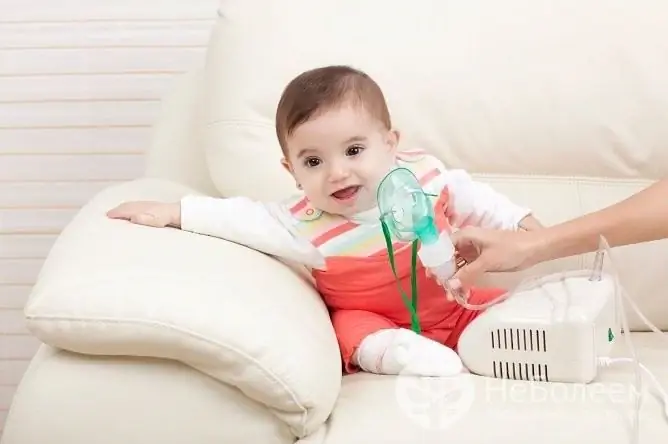
Inhalation for infants is carried out using a nebulizer
Inhalations are useful, which are carried out using a spray or nebulizer.
In order to facilitate sputum discharge, a therapeutic massage is performed.
With the right therapy, recovery usually occurs in 1.5-2 weeks.
What is forbidden to do with bronchitis in infants
Self-medication of infants is strictly prohibited. With bronchitis, this is fraught, at best, with the transition of the disease to a chronic form, at worst, with the spread of the pathological process to the lungs and the development of other, extremely severe, and sometimes life-threatening complications.
Infants are prohibited from:
- Inhalation with hot steam. Such inhalations are especially dangerous in the presence of an elevated temperature.
- Instill breast milk in the nose. It has no particular therapeutic effect, but it can cause additional difficulty in breathing.
- Put mustard plasters or cans, as well as pour mustard from the socks.
- Rub with turpentine ointment or any other similar action.
As for traditional medicine, their use in infants is extremely undesirable, since it is extremely difficult to maintain the correct dosage, as well as because of the high allergenicity of such drugs and the unscientific nature of most of these treatments. An exception can only be if a similar drug is prescribed by the attending physician.
Video
We offer for viewing a video on the topic of the article.

Anna Aksenova Medical journalist About the author
Education: 2004-2007 "First Kiev Medical College" specialty "Laboratory Diagnostics".
Found a mistake in the text? Select it and press Ctrl + Enter.

